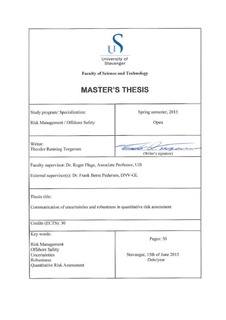| dc.contributor.author | Torgersen, Theodor Rønning | |
| dc.date.accessioned | 2015-09-25T11:39:49Z | |
| dc.date.available | 2015-09-25T11:39:49Z | |
| dc.date.issued | 2015-06-15 | |
| dc.identifier.uri | http://hdl.handle.net/11250/302041 | |
| dc.description | Master's thesis in Risk management | nb_NO |
| dc.description.abstract | The use of quantitative risk assessment, in all phases of an offshore oil and gas project in Norway, has clear requirements in NORSOK Z-013. The purpose of QRA is to describe the risk picture and give decision support through all project phases. These decisions are not only related to choosing between two or more alternative designs in concept selection phase and detail engineering. Important decisions with regards to safe design, barrier management, safe operations and organization, use information from the QRA.
In an early concept selection phase of a project, very limited site specific data is available and calculations must be done based on a set of assumptions and generalizations. Expert knowledge, historical and generic data is used.
Some generic data can be solid in an early phase project, such as meteorological data, ship traffic and information about earthquake rates, while other generic data like gas and oil spill rates may not even be representable for the new installation. Generic data reflects a wide variation in types, sizes and age of installations. The data also represents a wide geographical area, something that can have a significant impact as oil production is moved closer to the Arctic environment. The development and use of more and more subsea production facilities creates a larger difference between new and old installations.
Creating a risk picture based on generic data can have epistemic uncertainties that can be reduced. A QRA should focus on describing these uncertainties and the evolving process should focus on uncertainty reduction. Reducing epistemic uncertainties means increasing the strength of knowledge.
Classifying uncertainties by their strength of knowledge and the degree of sensitivity will give the risk assessor a tool to manage the risk better through the project phases. It will be clearer to the assessor and risk manager which knowledge that needs strengthening to reduce uncertainties according to the wanted effect, and help make better decisions to reduce risk. Assessing the strength of knowledge and sensitivity will identify the robustness of the QRA and can introduce a more effective way of reviewing and updating the risk picture as more knowledge is available.
In this thesis we perform a review of the available literature on such a new risk perspective, focusing on uncertainties and how it will apply to performing a QRA. The thesis will also show how this affects the complete project process from concept selection to operation and how a new risk perspective applies to the purpose and requirements stated in NORSOK Z013 for QRA. Through a case study where the new risk perspective is applied, we will show how the new risk perspective give the assessors the tools to better manage risk through all phases of a project from concept selection to operations and adds to the life cycle value of a project. | nb_NO |
| dc.language.iso | eng | nb_NO |
| dc.publisher | University of Stavanger, Norway | nb_NO |
| dc.relation.ispartofseries | Masteroppgave/UIS-TN-IØRP/2015; | |
| dc.rights | Navngivelse 3.0 Norge | * |
| dc.rights.uri | http://creativecommons.org/licenses/by/3.0/no/ | * |
| dc.subject | risikostyring | nb_NO |
| dc.subject | quantitative risk assessment | nb_NO |
| dc.subject | uncertainties | nb_NO |
| dc.subject | robustness | nb_NO |
| dc.subject | offshore safety | nb_NO |
| dc.subject | risk management | nb_NO |
| dc.title | Communication of uncertainties and robustness in quantitative risk assessment | nb_NO |
| dc.type | Master thesis | nb_NO |
| dc.subject.nsi | VDP::Social science: 200 | nb_NO |
| dc.source.pagenumber | 50 | nb_NO |

